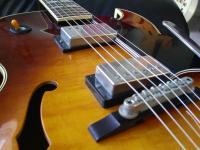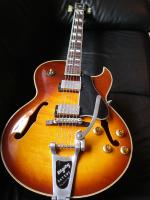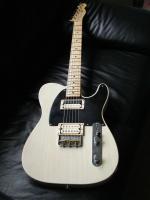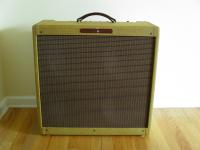Review of Lollar Imperial Humbuckers
In this review we will be actually reviewing two different sets of Jason Lollar Imperial Humbuckers. We will be installing a set of low wind and a set of regular wind models. There will be two test guitars. First a 1980's Greco ES 175 type guitar and a Tele-Gib project guitar. Each guitar is very different so we will get to see two different applications and how the pickups work in each setting.
On the Bench: Before I installed both sets of Lollar Imperials I wanted to measure the DC resistance to get an idea of how different the two sets actually were. The regular wind set measured as follows: Bridge= 8.42k, Neck= 7.62k. The low wind set read as follows: Bridge= 7.87k, Neck= 7.04k. Two completely different sets of pickups, for two completely different applications. Alnico 5 magnets that are degaussed to a specific level were common to both sets and this contributes to the vintage type PAF sound. All 4 pickups were wax potted (unlike original PAF pickups) but the potting helps to keep microphonic squeal to a minimum. I do not think that these pickups were "over-potted" based on a few conversations I had with Jason. Too much potting can sort of deaden a pickup. I ordered the low wind set for my 1980's Greco ES 175 type guitar and asked Jason to fit them with slightly aged nickel covers to match the naturally aged hardware on the guitar. The match was perfect! I ordered the regular wind set for my Tele-Gib project guitar and opted for no covers just like Jeff Beck's original. Jason aged the bobbins for me a little to give them a nice vintage appearance. They looked spot on! There is plenty of lead length for using these in archtop or Les Paul type guitars. Much of the lead length was not needed for the Tele-Gib. The build quality looked excellent and each pickup came with springs, mounting screws and wiring instructions. Also as a bonus there was a fiberboard guitar pick. Thanks Jason!
In the Shop: The stock pickups in the Greco were dark sounding and a little dull. They also lacked the springy-ness and dynamic bounce that a good sounding pickup has. The guitar itself felt great and had a warm, woody sound unplugged. It just needed new pickups. By the way, the stock Greco pickups were not the sought after DRY-Z units that are bringing in some good bucks right now.
After pulling the harness and removing the pickups from the Greco I was ready to do the installation. While I was under the hood I decided to change the stock pots for RS Guitarworks units. The RS pots do not make the guitar sound dark or dull when you turn the volume down. They feel very smooth and the taper is very even. I fit all my guitars with RS pots. They do make a difference. I also changed the capacitor to an RS paper in oil type. The Lollar pickups mounted perfectly in the stock rings and installation went smooth even though archtops can sometimes be a little tedious to work on. Now for the installation on the Tele-Gib.
Again the installation was easy and the Imperials fit perfectly into Gibson rings. The Tele-Gib project guitar was made from a Brian Poe two piece swamp ash body that weighed in at 3lbs-13oz. I shot the guitar myself in nitrocellulose lacquer with a nice later 1950's blonde color I concocted. The neck was made by Musikraft which was a one piece maple neck with a very large back  profile. I finished the neck in Tung oil for a natural, worn feel which I personally like. This guitar was also built with RS pots and an oil filled capacitor. Another thing I always use on Tele's are Glendale Guitars brass saddles which are angled to help with intonation. I cut a current production bridgeplate I found on ebay for about $15.00. In the end it was basically like a vintage repro Tele with humbuckers.
profile. I finished the neck in Tung oil for a natural, worn feel which I personally like. This guitar was also built with RS pots and an oil filled capacitor. Another thing I always use on Tele's are Glendale Guitars brass saddles which are angled to help with intonation. I cut a current production bridgeplate I found on ebay for about $15.00. In the end it was basically like a vintage repro Tele with humbuckers.
The test amp was my trusty 5F6-A Bassman clone using Mercury Magnetics transformers, Sozo caps, carbon comp resistors, a Larry Rodgers tweed covered pine cabinet and 4- Weber VST, 10A125 speakers. Current production Sovtek 12AX7LPS's and Tung Sol 5881's were used and the GZ34 was an N.O.S. General Electric. The amp was hand built by me here at 300Guitars.
 So how did they sound? First up, was the Greco ES 175. I set up the amp with the Volume between 9-10 o'clock, Treble 2 o'clock, Bass 9 o'clock, Middle 9 o'clock and Presence at 2 o'clock. Well, let me tell you what. This guitar came to LIFE with the Lollar low winds. It was a night and day difference as compared to the stock units. There was a nice warmth that sounded 3D and a richness that made the guitar sound wonderful. All the warm woody tone from the guitar came through. The high end was clear and not brittle or harsh. The springy-ness and bouncy dynamics were there is spades. The guitar now sounded amazing for jazz and western swing type sounds as well as some blues and rockabilly. The neck pickup was smoky but clear and turning down the tone pot you could get the jazz sounds of Wes Mongtomery and Joe Pass. The bridge unit sounded great for bluesy lines and Chuck Berry type double stops. Both pickups together sounded phenomenal for Merle Travis pickin' and Grant Green soloing. Everything I played sounded clear and balanced. The bottom strings had a woody, piano-like quality which was stunning through the classic 4x10 arrangement. I was extremely happy with this guitar and the original 1950's Bigsby I was saving all these years was the cherry on top!
So how did they sound? First up, was the Greco ES 175. I set up the amp with the Volume between 9-10 o'clock, Treble 2 o'clock, Bass 9 o'clock, Middle 9 o'clock and Presence at 2 o'clock. Well, let me tell you what. This guitar came to LIFE with the Lollar low winds. It was a night and day difference as compared to the stock units. There was a nice warmth that sounded 3D and a richness that made the guitar sound wonderful. All the warm woody tone from the guitar came through. The high end was clear and not brittle or harsh. The springy-ness and bouncy dynamics were there is spades. The guitar now sounded amazing for jazz and western swing type sounds as well as some blues and rockabilly. The neck pickup was smoky but clear and turning down the tone pot you could get the jazz sounds of Wes Mongtomery and Joe Pass. The bridge unit sounded great for bluesy lines and Chuck Berry type double stops. Both pickups together sounded phenomenal for Merle Travis pickin' and Grant Green soloing. Everything I played sounded clear and balanced. The bottom strings had a woody, piano-like quality which was stunning through the classic 4x10 arrangement. I was extremely happy with this guitar and the original 1950's Bigsby I was saving all these years was the cherry on top!
Next up was the Tele-Gib. I have to admit I love Telecasters. Everything about them. The squared off body, where the controls are located, the overall feel and balance and their durability just to name a few attributes. I decided to build this guitar because I really like humbuckers but after playing a Tele for 20+ years now it is just very comfortable and familiar. After thinking about Jeff Beck's Tele-Gib for a while now I thought is was time to finally build one. This way I can have a humbucker guitar with the familiarity of the Tele. I set up the amp with the Volume at between 1-2 o'clock, Treble 2 o'clock, Bass 9 o'clock, Middle 2 o'clock and Presence at 2 o'clock. Again I was floored by the Imperials! This guitar sounded like a bulked up, pissed off Tele that was ready to just explode. It felt like a Tele but sounded like what I thought a Gibson should sound like. Again the character of the guitars wood came through and had the same type of clarity of the low winds in the Greco. The bridge pickup sounded like a muscular Roy Buchanan and Jeff Beck. All the sustain you could want for long bluesy or rock solos just sang out of the guitar and that infectious woody, organic tone just sucked you in. I could also get a clucky, chicken' pickin' Tele sound with the volume turned down. The neck pickup sounded creamy and you could get a serious woman tone with the tone pot turned down a ways. But still there was that clarity. You could even get a little jazz thing happening with the neck pickup. Both pickups together reminded me of Steve Cropper a bit and the two pickup combination sounded sweet. It was a great tone for R&B and funk rhythm parts. I love my Teles and I was hooked.
On the Gig: The Greco performed like a champ on the gigs I took it to. All the richness and clarity that was heard in the shop environment was present and accounted for on the gig. For the rockabilly rave up numbers it sounded fantastic especially with both pickups combined. It was warm, fat and "bloopy"- you archtop players know what this term means. The bridge pickup was just blazing for bluesy lead solos. I could get close to the early Scotty Moore Sun Sessions sound even though he was using P-90s at the time. Playing in a band setting the guitar sounded great and the neck pickup retained the clarity to be heard amongst the stage racket. Feedback was minimal except for the occasional guitar's body closing in on the edge of archtop feakout while using the neck pickup at loud volume. This was totally manageable though and never got away from me.
Now the Tele-Gib was something else altogether. This guitar is an animal and should be played like one. The harder I dug in with my pick the more the guitar and amp liked it and seemed to want more. This is not a set-up for dainty Chet Atkins finger picking articulation, although the clarity was excellent. This is a set-up for an emotional player that wants to annihilate the listener and for listeners who want to be annihilated! Single notes sang and jumped out of the guitar with ease. Chords stayed clear up and down the neck. This guitar sounded awesome for the rock and blues stuff. With the bridge pickup I could get a Santana like tone with my Blackstone 2SV3 overdrive pedal in conjunction with my Analogman Orange Squeezer (Squeezer first into the Blackstone). Black Magic Woman never felt so good. I could even conjure up a Peter Green tone from that blistering bridge pickup. It was vintage Clapton-land with the neck pickup and the tone rolled down a bit. Crossroads! And the two pickups combined was great for funky rhythm parts and had a nice sweet blues sound for solos. And all the while there was this organic thing happening under all the clarity and the body of each note or chord. It was like a sizzle and not grainy at all. Almost like a built in added bonus of texture. Not a hint of squealing feedback at all even with the Squeezer and Blackstone together. The rig stayed in total control without sounding or feeling like it was stifled. A total experiment that was a home run!
Final Analysis: If you are looking for a great PAF humbucker type pickup look no further. Jason has the art of pickup making down and all his experience goes into each unit that he builds. I do not subscribe to the older or vintage is always better way of thinking. With all the knowledge that has been accrued through time and experience it only makes sense that someone who has the talent and intuitive skill could build a pickup that would sound fantastic and on a consistent basis. A lot of the old pickups are hit and miss for many, many reasons. There was no thought of how building materials affected tone to match certain types of guitars and varied styles of music. Pickups were designed and then just built on a production line as a component of the guitar with materials that were available at the given time. Magnets varied, wire varied, etc and then there is the element of time. We cannot go back in time to A/B compare a brand new, freshly wound circa 1959 pickup with a current production unit. I think the best way to approach choosing pickups is with the sound and feel you have in your head and then try to find the pickup that suits your style best. At that point it does not matter what it is made out of. You can certainly find a pickup from Jason Lollar for your needs that will inspire you to play at your best. Lollar pickups can be purchased directly from Jason's website. Place your order, prepare your guitar for a pickup transplant and then prepare your ears and soul for a rockin' good time!